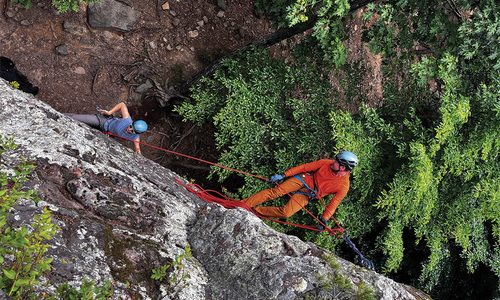Camping
Tips on Bear Safety from Josh Wisdom
Spring is upon us, and the bears are creeping out of hibernation. Here is how to keep your yard safe courtesy of Josh Wisdom, Wildlife Biologist with the Missouri Department of Conversation.
By Jordan Blomquist
Apr 2024

In the leafy green forests of southwest Missouri, the bear population is growing. “I can tell you that we’ve gotten around 9% growth,” says Josh Wisdom, a Wildlife Damage Biologist with the Missouri Department of Conservation. “Nine percent means that our numbers will double about every 10 years.”
My family lives in Ozark and has seen bears perusing the neighborhood on a few occasions—a cub even ran in front of my car last summer on an evening drive home.
Each spring, our neighborhood Facebook page begins to flood with photos of bears from home security cameras and posts like, “Bear is behind our house!” or “Just saw the bear get into our trash,” or, my personal favorite, “The BEAR is back.” Wisdom says bears usually begin coming out of hibernation around April 1, but we can always gauge their return by observing our horses’ reactions. “Last year, our horse Champ was super skittish and we knew something was up,” my mother, Holli Thornsberry, says. “Then our neighbors spotted a bear in their backyard, so we knew he had been close.”
Wisdom says the increase in bear population is because they have few to no predators in the Midwest. “Competition between bears remains low for the time being, which means there are plenty of resources available to them,” he says. With the rise in population comes a greater risk that humans and bears come in contact more often.
You may have spotted a bear walking out of the woods or seen one on the neighborhood Facebook page, but do you know what to do if you come face-to-face with the furry creatures in your own yard? We have the tips you need to steer clear of a negative run-in with a bear.
What To Do If You See a Bear
The main thing to know if you encounter a bear is to never feed them—whether on purpose or not. “Anything that a bear can eat, they will,” Wisdom says. That includes dog food—or in my family’s case, grain for the horses—sunflower seeds, suet cakes and even sugar water in a hummingbird feeder. “If there’s nothing for them, they’re not going to stick around,” Wisdom says
If you see a bear in close range, make sure they see you, too. “I like to say, ‘If you care, scare the bear,’” Wisdom says. Whether that’s clapping your hands or honking your car horn, make sure the bear knows you’re there. Upon hearing you, the bear may stand up on its hind legs. Contrary to depictions in movies, this behavior isn’t intended to frighten. Wisdom says bears actually have bad eyesight and adopt this stance to gain a better view of their surroundings.
Save the Chickens!
Wisdom has heard an increasing number of stories about bears attacking backyard chickens across the Ozarks. What many people don’t know is bears are not interested in the chickens themselves, they’re after the chicken feed. “It’s a very common practice for people to leave a trash can full of sweet feed inside their coop,” Wisdom says. Although a bear might encounter a chicken or two in the coop, a solution to prevent this is to install an electric fence around the area. “You can get it from your farm and home stores,” he says.











